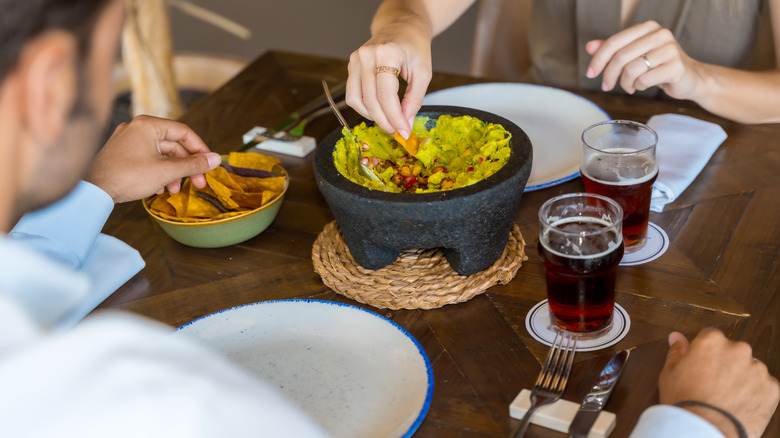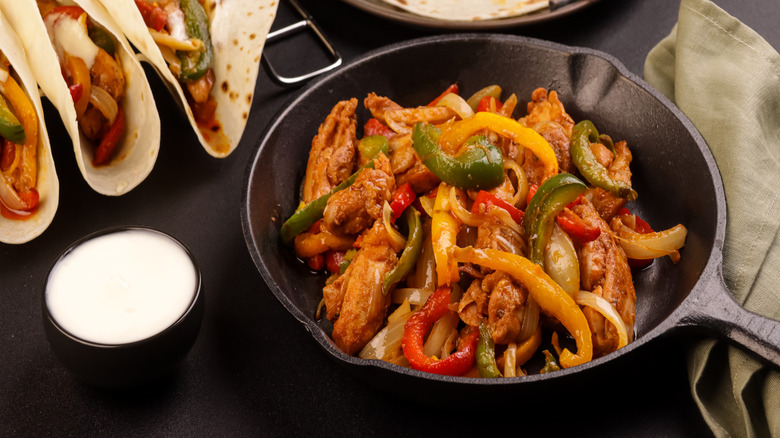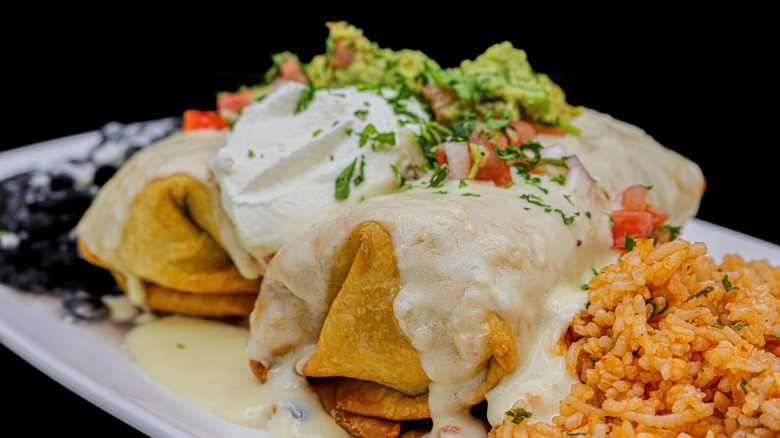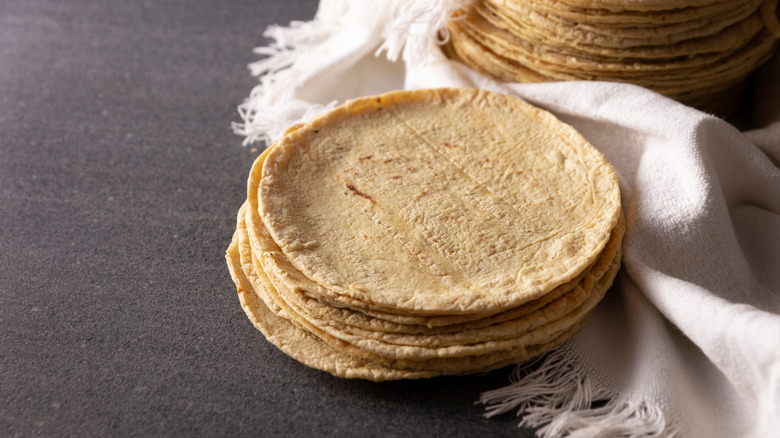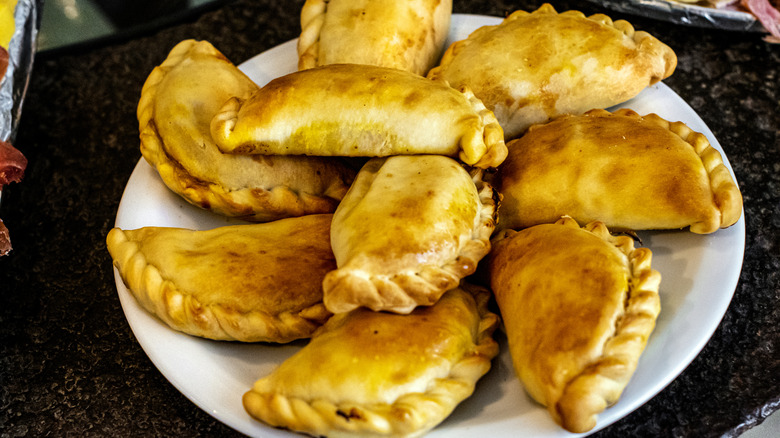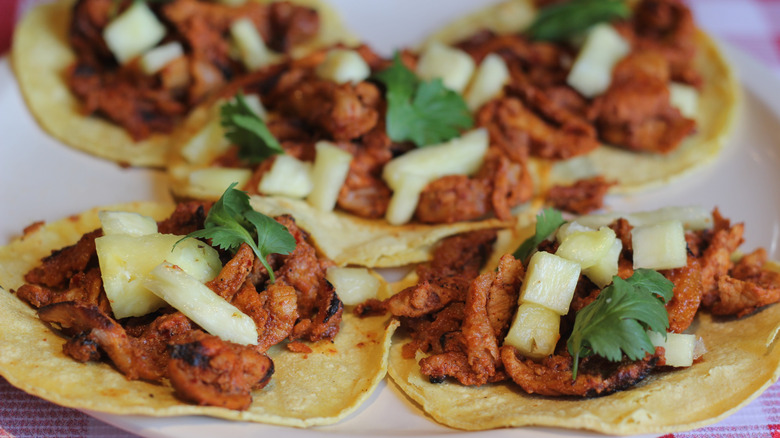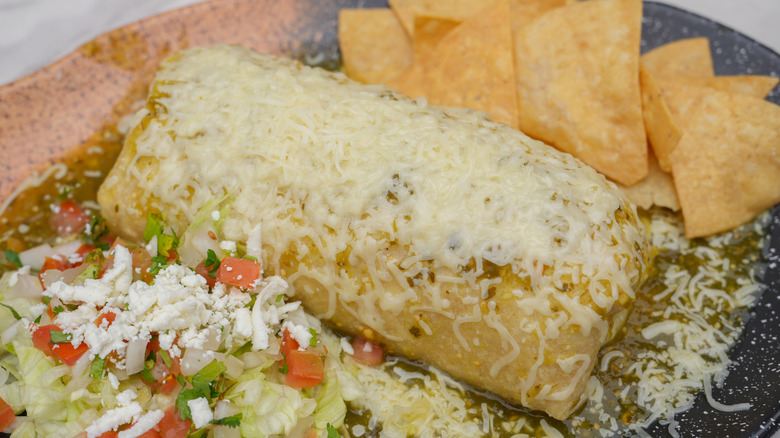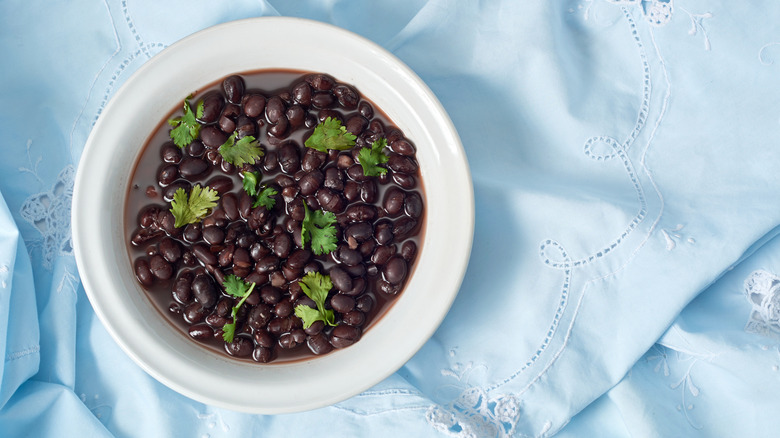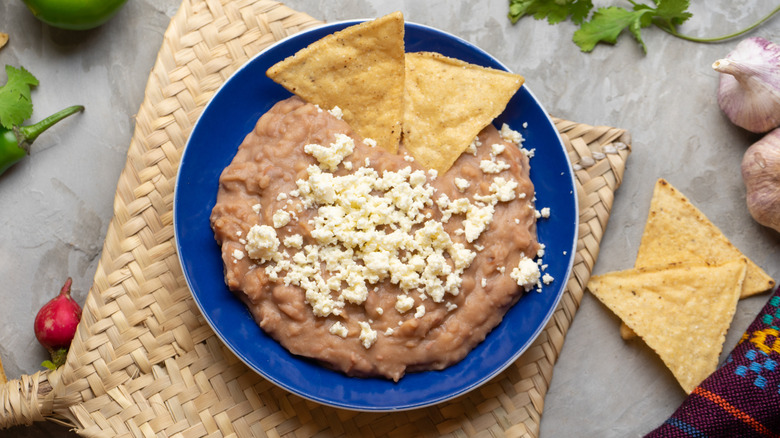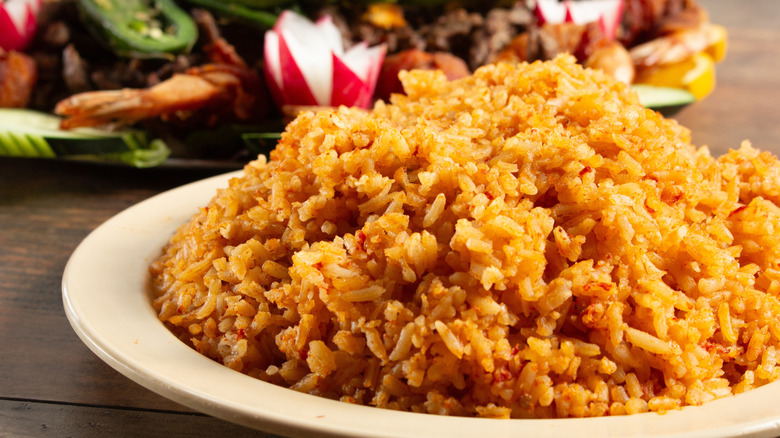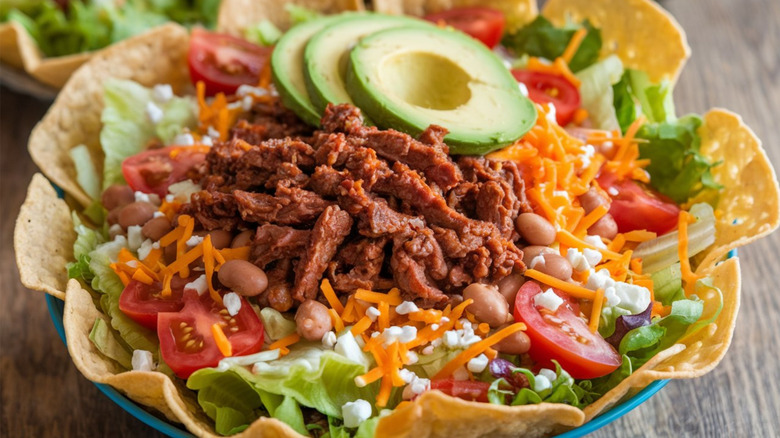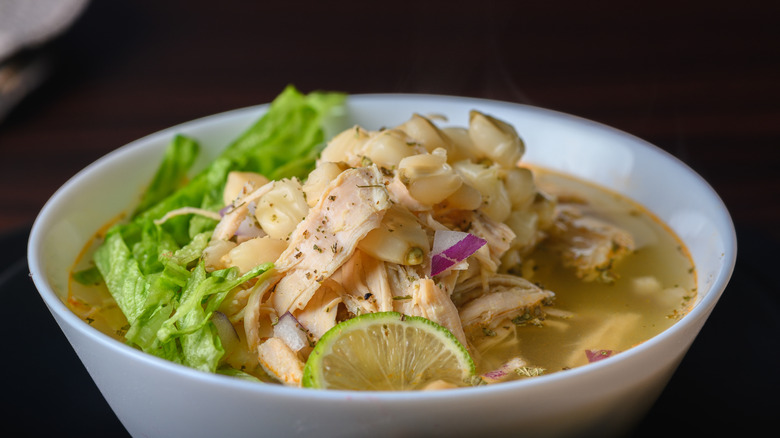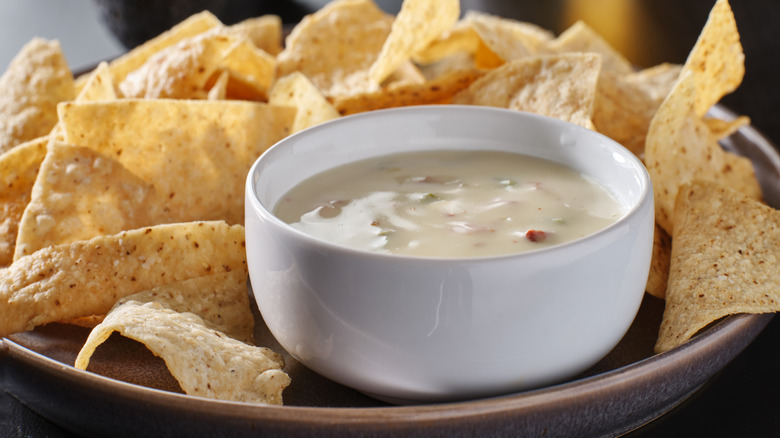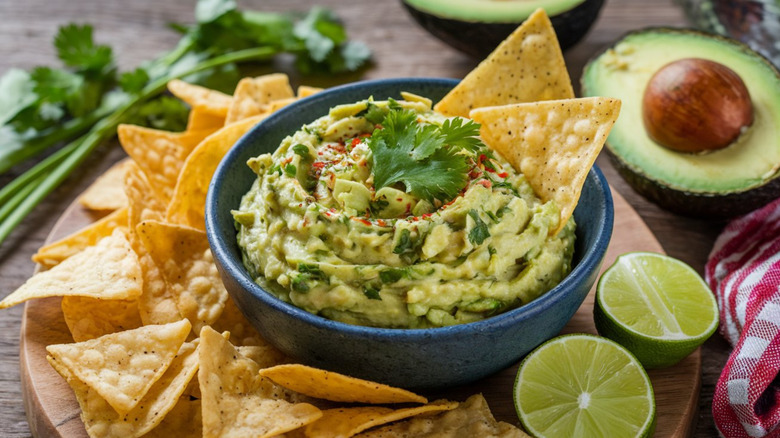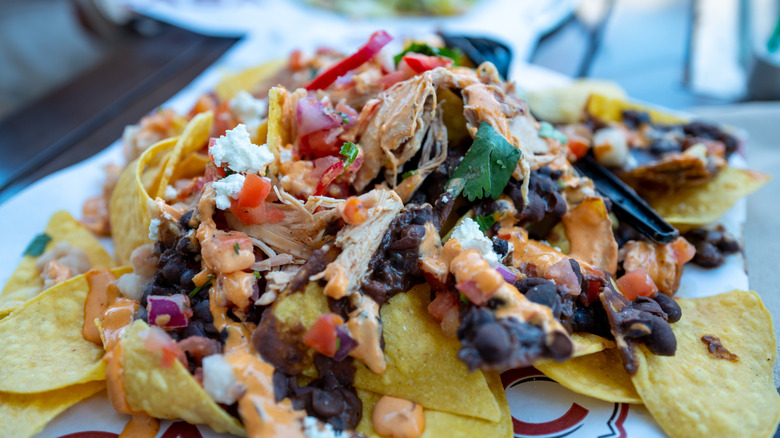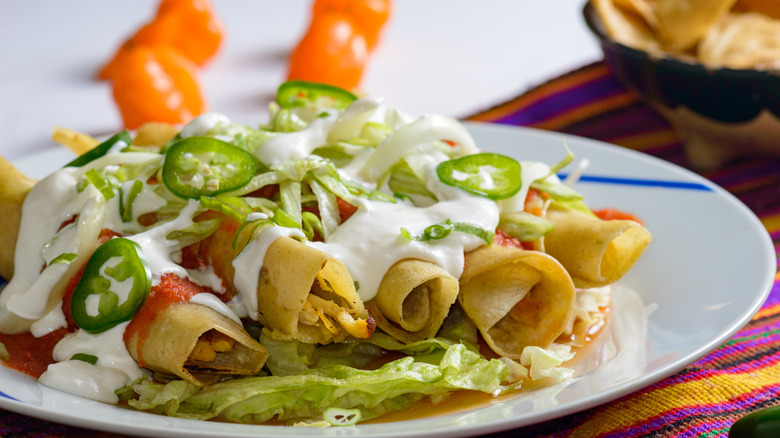8 Healthiest And 7 Unhealthiest Foods To Order At A Mexican Restaurant
Whether you're dining out at your favorite locally owned Mexican spot or you're headed to a large chain where you can reliably order the same enchilada-beans-and-rice combo every single time, you probably expect Mexican food to be at least moderately healthy, right? Beans are generally considered good for you, as is rice. Mexican restaurants may not be as reliant on their deep fryers as some other types of restaurants, and you don't need to worry about avoiding huge amounts of carb-y pasta and cheese, like you might when navigating the healthiest and unhealthiest foods to order at an Italian restaurant.
However, while there are a handful of healthy items on many Mexican restaurant menus, you might just be surprised at what's lurking within some of the menu items that seem, on first consideration, nutritiously sound. In reality, they're doing less for your health than you might like. These are some of the healthiest and unhealthiest foods to order at a Mexican restaurant.
Healthiest: Fajitas
They're a Mexican restaurant classic. Everyone in the building turns their head when they hear the sizzling pan making its way through the room — and, thankfully, this is one of the menu items that are typically a safe bet. This is particularly true if you're trying to limit the amount of carbs and fat you're eating while also prioritizing lean meats and vegetables. Opt for chicken fajitas over steak, and ask for corn tortillas instead of flour, to get the greatest benefits possible.
Curious about what difference it makes ordering the fajitas instead of another classic, like a burrito? Consider On the Border's classic fajitas selections; you can get an order of fajitas that contains as little 240 calories, or as few as 11 grams of carbs, and more than 40 grams of protein in a serving. Compare that to the chain's classic burritos, which come with a minimum 680 calories and more than 50 grams of carbs per order.
Unhealthiest: Chimichangas
Want to make an already potentially unhealthy burrito even less healthy? Deep fry it. This, of course, will leave you with the chimichanga. Unfortunately, anytime you deep fry something, you're going to be adding excess calories and fat, and fried foods in general can cause bodily inflammation, damaging your gut and heart health. As such, a chimichanga is one of the less-than-ideal menu items you could order at a Mexican restaurant.
On the Border's classic chimichangas, with no sauce added (and who's going to eat a chimichanga without the sauce?), start at 800 calories each, but that's not the really eye-watering part; the chain's chimichangas also have at least 2,150 milligrams of sodium each, which is nearly the entirety of the daily recommended limit set by the government's Dietary Guidelines for Americans, for optimum health. Furthermore, when you add on your chimichanga's sauce, you could be pouring an additional 880 milligrams of sodium onto your plate, if you choose the classic queso.
Healthiest: Corn tortillas
Whether you're ordering enchiladas, tacos, or anything else, if you have a choice between flour and corn tortillas, opt for the latter. Not only are corn tortillas typically a safe bet for those with gluten sensitivities, but corn tortillas are less processed than flour tortillas; often higher in good stuff like fiber and magnesium; and often lower in undesirable stuff like fat, sodium, and sugar.
Regional chain Café Rio offers not just flour and corn tortillas, but also wheat tortillas — so how do they stack up against one another? A six-inch flour tortilla at the chain contains 170 calories and 5 grams of fat. A six-inch wheat tortilla contains 190 calories and 7 grams of fat. Meanwhile, the six-inch corn tortilla contains just 60 calories and 0.5 grams of fat.
That said, if you have specific health goals in mind — like watching your caloric intake versus your sodium intake, or vice-versa — you'll want to examine your particular restaurant's nutritional details. This is because, while, in general, corn tortillas may be lower in sodium than flour tortillas, that's not the case at Café Rio, where the corn tortillas come with 135 milligrams of sodium, compared to the no sodium in the restaurant's flour and wheat tortillas.
Unhealthiest: Empanadas
Like chimichangas, empanadas are one of those fried foods that you really are going to want to avoid when dining out at Mexican restaurants, if you're trying to reduce how much fat, calories, and sodium you consume. At On the Border, the savory empanadas are served as a starter, but they easily pack in enough calories and sodium to count for an entire meal — or even your entire day's worth of calories and sodium, depending on your individual health goals.
An order of empanadas at the chain comes with at least 1,110 calories, plus 70 grams of fat, including 24 grams of saturated fat and 2 grams of trans fat. Meanwhile, they pack in at least 2,120 milligrams of sodium. The trans fat is of particular note. You'll find that not a lot of foods anymore come with trans fat, given the widespread adoption of the belief that these are the overall worst fats for your health; however, they still pop up in some foods, where they can actively raise your bad cholesterol while lowering your good cholesterol. The American Heart Association advises individuals avoid trans fats as much as possible, with no amount deemed healthy.
Healthiest: Tacos al pastor
Tacos in general are a good idea when dining out at a Mexican restaurant, and for several reasons. They're very versatile, for one, so you can mix and match toppings to create the healthiest option (by, for instance, asking for corn shells instead of flour shells, and lean meats instead of ground beef or steak). They also typically come in small portions, so you can better gauge your fullness and stop eating when you're satiated.
Tacos al pastor in particular manage to squeeze in a lot of flavor without sacrificing your health. The pork used is typically a lean cut, and the pineapple topping, combined with the traditional spices, provide extra flavor without adding extra calories, sodium, or fat in the way that a creamy sauce might.
At regional chain Taco Palenque, the tacos al pastor contain 310 calories (though you can reduce that by ditching the flour tortilla for a corn tortilla), 17 grams of fat (compared to, for example, the 34 grams of fat in the bean and cheese tacos), and 710 milligrams of sodium, making it one of the lesser-sodium-rich taco options on the menu.
Unhealthiest: Burritos
We've already given burritos a bit of flack for their less-than-ideal spot among the least-healthy Mexican chain menu items, and for good reason. Burritos often come swathed in a giant flour tortilla. Restaurants seem to take a bigger-is-better approach, with some doling out burritos as big as a baby. Sometimes, burritos are also covered in a creamy, fatty, salty sauce. It all makes these menu items fall to the bottom of the pack.
This is the case whether you're looking at a sit-down chain or a fast-casual chain like Chipotle. For Chipotle, a chicken burrito with brown rice, fajita veggies, and cheese clocks in at 840 calories, 92 grams of carbohydrates, and 30 grams of fat. Add on another 320 calories if you want to double-wrap that burrito. Opt for a burrito bowl, though, with the exact same ingredients, and you're only at 520 calories, 21 grams of fat, and 42 grams of carbs.
Healthiest: Black or pinto beans
A high-protein and high-fiber food, black or pinto beans are one of your best side dish options at a Mexican restaurant. In fact, if you're looking to up your meal's nutritional value further, consider even ditching the chicken or steak you might be having as part of your entrée altogether and ask the restaurant if you can sub in beans instead.
At Taco Bueno, the black beans are 170 calories per serving, and the lowest side dish option on the menu in terms of fat, with a nice 0 grams. Meanwhile, the beans offer 11.9 grams of fiber and 10.2 grams of protein.
The one thing you might want to watch out for when ordering beans at a Mexican restaurant is sodium content, if that's a concern for you. If it is, or if you just find plain beans boring, you might ask if the restaurant offers frijoles a la charra, which are pinto beans in broth, which makes a nice alternative.
Unhealthiest: Refried beans
The refried beans are an unfortunate pitfall. Yes, they're beans, so they have a lot of the qualities that make beans great — such as fiber and protein — but they also have extra fat and salt that you won't find in non-fried beans.
If you compare the black beans and refried beans at Abuelo's, you'll see that the black beans have 140 calories compared to the refried beans' 260 calories; the black beans have 3 grams of fat compared to the refried beans' 8 grams. The refried beans also contain the dreaded trans fat while the regular black beans do not. Further, the black beans contain 380 milligrams of sodium compared to the refried beans' 640 milligrams, and the black beans contain 21 grams of carbohydrates compared to the refried beans' 35 grams. The only area in which the black beans fall short of the refried beans is when it comes to sugar. The black beans have a mere 1 gram of sugar, while the refried beans have none.
Healthiest: Mexican or Spanish rice
Another smart side dish choice that you'll find on many menus is Mexican or Spanish rice. What's the difference? Spanish rice traditionally contains saffron, while Mexican rice relies on cumin, but they both might include added vegetables like tomato and peppers, which introduce further health benefits to this already low-calorie, generally healthful side. That said, if the restaurant offers brown rice, you might opt for it instead, as it'll have more fiber and protein than the white rice used in Spanish and Mexican rice dishes. However, you're more likely to find brown rice at a fast-casual chain like Chipotle than you are at a sit-down, more traditional Mexican or Tex-Mex eatery.
At Abuelo's, the Mexican rice is one of the lower-calorie, lower-fat side options, with 110 calories compared to the 260 calories you'll find in the refried beans, and 3.5 grams of fat as compared to the 8 grams of fat also in the refried beans. At Taco Bueno, the Mexican rice comes with 207 calories compared to the 467 calories you'll get in the chain's "party beans" and 4.2 grams of fat as compared to the 16.4 grams of fat in the guac, 32.3 grams of fat in the party beans, and 11.1 grams of fat in the queso.
Unhealthiest: Taco salads
Taco salads — and really restaurant salads in general — are one of those foods that can seem healthy at first glance, but when you dig deep into the nutrition facts, you may just find some information that you really don't like. For example, if your taco salad comes with a creamy ranch or similar dressing, that's going to add calories and fat. Taco salads also often come served in a deep-fried tortilla bowl, which further complicates things. They might likewise be topped with a variety of sneaky, fatty, salty toppings like extra cheese, tortilla strips, or sour cream — all the while being massive. As such, if you're craving a taco salad, you might ask for the restaurant to nix the tortilla bowl, and serve your taco salad on a plate with a salsa topping rather than a creamy salad dressing.
Taco Bueno offers a variety of salads and bowls, but the taco salads stand apart as some of the higher-calorie, higher-fat, and definitely higher-sodium options. For example, the chain's chicken taco salad contains more than 2,400 milligrams of sodium — more than you're advised to consume in a day — but you can order a steak nacho salad instead and cut that sodium by more than half.
Healthiest: Soup
You might not think of soup when you're going out to get Mexican food, but don't sleep on the menu's soup offerings — they may just surprise you. Broth-based soups like tortilla soup can provide protein, fiber, and healthy fats, while keeping things a little lower in overall fat and calories. You might even get to try a less-familiar soup if you begin exploring your options, like caldo de camaron, which is a vegetable and seafood soup, or sopa de verduras, a Mexican vegetable soup.
Taco Palenque serves a variety of soups, the large majority of which are under 500 calories per serving. For example, the chain's sopa de fideo, which is basically like a tomato and noodle soup, contains just 270 calories for a large bowl, and only 5 grams of fat. That said, that particular soup is high in sodium, so if you were watching your sodium in particular, you might choose the chain's menudo, which has 1,140 milligrams of sodium per small serving. At Abuelo's, you can get a cup of tortilla soup for 230 calories, 10 grams of fat, and only 530 milligrams of sodium.
Unhealthiest: Queso
No one wants to hear it, but it must be said. The queso, which you eagerly await, mouth watering as soon as you sit down and the server slides a bowl of tortilla chips in front of you. The queso, which you can easily scarf down before you even get your margarita ... well, it isn't exactly chockfull of health benefits. Creamy, cheesy queso is going to be one of the higher-calorie, higher-fat sauce or dip options on any Mexican restaurant menu.
At Chipotle, just a small side of queso contains 240 calories and 18 grams of fat, before you even begin eating any chips (which come with 540 calories and 25 grams of fat, for a standard serving). At Taco Bueno, the small chips with queso contains 435 calories, 23.4 grams of fat, and 642 milligrams of sodium. Abuelo's offers two queso options, both of which contain more than half of your recommended sodium for the day.
Healthiest: Guacamole
While guacamole can contain 180 calories in just a half-cup, it's still filled with healthful fats and nutrients from the avocados that can make this appetizer and dip a rewarding part of your meal. It's the chips that often ruin everything. Restaurant tortilla chips — which are extremely easy to eat in excess — can add hundreds of calories and lots of extra fat to your meal. As such, istead of dipping chips, consider ask for raw veggies for dipping in your guac, or eat your guac as a sauce alongside your main meal.
If you're not sure just how much your chips are impacting your guac-and-chips habit, consider that a standard serving of chips at Chipotle is 540 calories. If you add guacamole, the calorie count only goes up to 770 — meaning, while avocado may have a fatty reputation, it's the benign-looking tortilla chips that may just be messing with your dietary goals.
Unhealthiest: Nachos
If you must eat tortilla chips (which — hey — we all deserve a treat every now and then, and these chips could very well be a part of your overall balanced diet), maybe just don't go for tortilla chips weighed down by a plethora of cheese, creamy sauces, and salty accompaniments, aka nachos. They're widely known as one of the unhealthiest options on a menu.
The On the Border stacked nachos, for instance, come with 2,000 calories (so potentially enough to hold you over for the entire day), plus 127 grams of fat, 1 gram of trans fat, and a truly frightening 3,810 milligrams of sodium. Similarly, at Abuelo's, the nachos can have up to 2,190 calories, depending on the protein you pick, and up to 2,820 milligrams of sodium. Abuelo's nachos likewise contain trans fat. At Taco Bueno, the situation is slightly better, but not by much. The chain's beef mucho nachos come with 1,121 calories and 2,667 milligrams of sodium and, yes, trans fat.
Healthiest: Flautas
Yep, it's another deep-fried Mexican food. However, flautas get a technical "healthiest" ranking because, out of all the various deep-fried Mexican foods you could order, flautas are your best option, at least compared to empanadas and certainly chimichangas. Flautas are basically a rolled taco, filled with chicken or other meat, then deep-fried. The smaller size and often lesser fillings give flautas an edge over chimichangas for sure.
At On the Border, you can grab an order of chicken flautas for 610 calories and 1,360 milligrams of sodium. While, again, not perfect, that's far better than the 2,150 milligrams of sodium that you'll find in the chain's chimichangas. Meanwhile, at Taco Palenque, you can get a full flautas meal, with rice and refried beans included, for just 850 calories and 1,800 milligrams of sodium. When you consider that refried beans are one of the unhealthier options on the menu, this is an overall meal that can both cure your cravings while also ensuring your health goals don't fly out the window.
